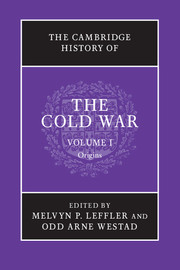Book contents
- Frontmatter
- 1 The Cold War and the international history of the twentieth century
- 2 Ideology and the origins of the Cold War, 1917–1962
- 3 The world economy and the Cold War in the middle of the twentieth century
- 4 The emergence of an American grand strategy, 1945–1952
- 5 The Soviet Union and the world, 1944–1953
- 6 Britain and the Cold War, 1945–1955
- 7 The division of Germany, 1945–1949
- 8 The Marshall Plan and the creation of the West
- 9 The Sovietization of Eastern Europe, 1944–1953
- 10 The Cold War in the Balkans, 1945–1956
- 11 The birth of the People’s Republic of China and the road to the Korean War
- 12 Japan, the United States, and the Cold War, 1945–1960
- 13 The Korean War
- 14 US national security policy from Eisenhower to Kennedy
- 15 Soviet foreign policy, 1953–1962
- 16 East Central Europe, 1953–1956
- 17 The Sino-Soviet alliance and the Cold War in Asia, 1954–1962
- 18 Nuclear weapons and the escalation of the Cold War, 1945–1962
- 19 Culture and the Cold War in Europe
- 20 Cold War mobilization and domestic politics: the United States
- 21 Cold War mobilisation and domestic politics: the Soviet Union
- 22 Decolonization, the global South, and the Cold War, 1919–1962
- 23 Oil, resources, and the Cold War, 1945–1962
- Bibliographical essay
- Index
- References
19 - Culture and the Cold War in Europe
Published online by Cambridge University Press: 28 September 2010
- Frontmatter
- 1 The Cold War and the international history of the twentieth century
- 2 Ideology and the origins of the Cold War, 1917–1962
- 3 The world economy and the Cold War in the middle of the twentieth century
- 4 The emergence of an American grand strategy, 1945–1952
- 5 The Soviet Union and the world, 1944–1953
- 6 Britain and the Cold War, 1945–1955
- 7 The division of Germany, 1945–1949
- 8 The Marshall Plan and the creation of the West
- 9 The Sovietization of Eastern Europe, 1944–1953
- 10 The Cold War in the Balkans, 1945–1956
- 11 The birth of the People’s Republic of China and the road to the Korean War
- 12 Japan, the United States, and the Cold War, 1945–1960
- 13 The Korean War
- 14 US national security policy from Eisenhower to Kennedy
- 15 Soviet foreign policy, 1953–1962
- 16 East Central Europe, 1953–1956
- 17 The Sino-Soviet alliance and the Cold War in Asia, 1954–1962
- 18 Nuclear weapons and the escalation of the Cold War, 1945–1962
- 19 Culture and the Cold War in Europe
- 20 Cold War mobilization and domestic politics: the United States
- 21 Cold War mobilisation and domestic politics: the Soviet Union
- 22 Decolonization, the global South, and the Cold War, 1919–1962
- 23 Oil, resources, and the Cold War, 1945–1962
- Bibliographical essay
- Index
- References
Summary
In Graham Greene’s postwar screenplay, The Third Man, American pulp author Holly Martins is invited by an old friend, Harry Lime, to Vienna, a city once known as the high cultural bulwark of Europe now occupied by the Allied forces, to give a talk at the British Cultural Re-education Centre. Ignorant of high culture, Martins represents the American innocent and ignorant abroad who refuses to believe that his well-educated friend now worships dictators and crime. “Don’t be so gloomy,” Lime offers at one point. “[I]n Italy, for thirty years under the Borgias they had warfare, terror, murder, and bloodshed – they produced Michelangelo, Leonardo da Vinci, and the Renaissance. In Switzerland, they had brotherly love, 500 years of democracy and peace, and what did that produce? The cuckoo clock.” In a nutshell, The Third Man encapsulates European cultural development in the Cold War: the bipolar conflict unfolding amidst the ruins of Europe; the intensifying propaganda war for the minds of men; the clash between high and popular culture, between tradition and modernity; the cliché that Americans have no culture; and the fact that, in the end, the winners do not take it all.
The Cold War as a cultural contest
Culture constitutes the transmission of ideas, dreams, mores, traditions, and beliefs from one generation to the next, from one continent to another, from one group of people to another in the form of schools, galleries, orchestra halls, shopping centers, department stores, and information centers. A painting, a composition, a poem, or a film constitutes part of culture when people receive, listen to, or look at it. It is the desire to pass on information that makes an artistic or intellectual inspiration part of culture. In Europe, the Cold War shaped a new way of transferring and selling ideas, values, productions, and reproductions. State interest, geopolitical strategy, ideological preconceptions, obsessive self-definition, and the continuous challenge of an enemy image dictated its contours to an unprecedented degree. In that sense, the Cold War was a war about two different Weltanschauungen, two ways to organize cultural life, two possibilities of defining modernity and grappling with its most daunting cultural challenge: how to preserve cultural tradition in the face of impending massive social change.
- Type
- Chapter
- Information
- The Cambridge History of the Cold War , pp. 398 - 419Publisher: Cambridge University PressPrint publication year: 2010
References
- 16
- Cited by



